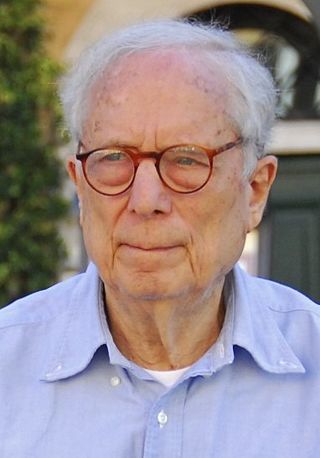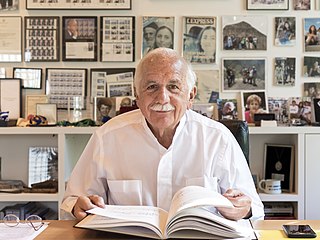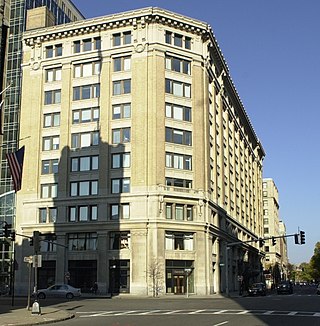
Robert Charles Venturi Jr. was an American architect, founding principal of the firm Venturi, Scott Brown and Associates, and one of the major architectural figures of the twentieth century.

Moshe Safdie is an Israeli architect, urban planner, educator, theorist, and author. He is known for incorporating principles of socially responsible design throughout the course of his six-decade career. His projects include cultural, educational, and civic institutions; neighborhoods and public parks; housing; mixed-use urban centers; airports; and master plans for existing communities and entirely new cities in the Americas, the Middle East, and Asia. Safdie is most identified with designing Marina Bay Sands and Jewel Changi Airport, as well as his debut project Habitat 67, which was originally conceived as his thesis at McGill University. He holds legal citizenship in Israel, Canada, and the United States.

Josep Lluís Sert i López was a Spanish architect and city planner.

Charles Bulfinch was an early American architect, and has been regarded by many as the first American-born professional architect to practice.

Robert Arthur Morton Stern, is a New York City–based architect, educator, and author. He is the founding partner of the architecture firm, Robert A. M. Stern Architects, also known as RAMSA. From 1998 to 2016, he was the Dean of the Yale School of Architecture.

Collegiate Gothic is an architectural style subgenre of Gothic Revival architecture, popular in the late-19th and early-20th centuries for college and high school buildings in the United States and Canada, and to a certain extent Europe. A form of historicist architecture, it took its inspiration from English Tudor and Gothic buildings. It has returned in the 21st century in the form of prominent new buildings at schools and universities including Cornell, Princeton, Washington University, and Yale.

McKim, Mead & White was an American architectural firm based in New York City. The firm that came to define architectural practice, urbanism, and the ideals of the American Renaissance in fin de siècle New York City.

Charles Allerton Coolidge (1858–1936) was an American architect best known as a partner in the architecture firm of Shepley, Rutan & Coolidge of Boston and Chicago, successors to the firm of architect Henry Hobson Richardson and one of the best-known architecture firms in the United States. Coolidge was also senior partner in that firm's successors, Coolidge & Shattuck and Coolidge, Shepley, Bulfinch & Abbott of Boston and Coolidge & Hodgdon of Chicago.

Charles Amos Cummings was a nineteenth-century American architect and architectural historian who worked primarily in the Venetian Gothic style. Cummings followed the precepts of British cultural theorist and architectural critic John Ruskin (1819–1900). Cummings help to found the Boston Society of Architects in 1867.
Shepley, Rutan and Coolidge was a successful architecture firm based in Boston, Massachusetts, United States, operating between 1886 and 1915, with extensive commissions in monumental civic, religious, and collegiate architecture in the spirit and style of Henry Hobson Richardson.
Shepley Bulfinch is an international architecture, planning, and interior design firm with offices in Boston, Hartford, Houston, and Phoenix. It is one of the oldest architecture firms in continuous practice in the United States, and was recognized by the American Institute of Architects with its highest honor, the AIA Architecture Firm Award, in 1973.

The Church of the Holy Cross (1803-ca.1862) was located on Franklin Street in Boston, Massachusetts. In 1808 the church became the Cathedral of the Holy Cross. It was designed by Charles Bulfinch and was the first church built for the city's Roman Catholics.
Robert Campbell is a writer and architect. He is currently an architecture critic for the Boston Globe. He lives and works in Cambridge, Massachusetts.

The Middlesex County Courthouse is a historic courthouse building in East Cambridge, Massachusetts. It was initially designed in 1814-1816 by noted architect Charles Bulfinch (1763–1844), and subsequently enlarged in 1848 by Ammi B. Young.
Alexander Cooper, FAIA, often credited as Alex Cooper, is an American architect and urban designer. In his 1987 piece on Cooper in The New York Times, Paul Goldberger wrote that Cooper "might be the most influential architect in New York right now. Surely, no architect is having as much impact, not only on the design of individual buildings, but on the shape of wide swaths of the city."
Jaquelin Taylor Robertson, FAIA, FAICP, informally known as "Jaque," was an American architect and urban designer, working at Cooper Robertson. He was a representative of New Urbanism and New Classical Architecture.

Densmore and LeClear was an architecture and engineering firm based in Boston, active from 1897 through 1941.
George Gund II was an American banker, business executive, and real estate investor who lived in Cleveland, Ohio, in the United States. He inherited his father's fortune and used a portion of it to purchase alien property seized during World War I. He sold this business at significant profit, and invested widely in banking, insurance, and real estate. Among his investments were a large number of shares in the then-small Cleveland Trust Company. Gund became a director of the bank in 1937 and president in 1941. He led the transformation of the institution into one of the largest banks in the United States. He retired as president in 1962, and was named chairman of the board of directors. A philanthropist for most of his life, he established The George Gund Foundation in 1952.
Andrea Leers is an American architect and educator. Together with Jane Weinzapfel, Leers created the Boston-based architecture firm Leers Weinzapfel Associates which was the first woman-owned firm to win the American Institute of Architects Architecture Firm Award in 2007. In 1991, she was elected to the American Institute of Architects College of Fellows.
Buttrick White & Burtis was an architecture firm established in New York City in 1981 by the architects Harold Buttrick, Samuel G. White, and Theodore A. Burtis III. The firm remained active until 2002. Harold Buttrick left in 1998 to form Murphy Burnham & Buttrick. The architect Jean P. Phifer was a partner of the firm from 1989 until 1996, after which she served as president of the New York City Public Design Commission from 1998 to 2003. The architect Michael Dwyer was associated with the firm from 1981 to 1996. The architect and educator William W. Braham was associated with the firm from 1983 to 1989. In 2002, Buttrick White & Burtis merged with Platt Byard Dovell to become Platt Byard Dovell White.














